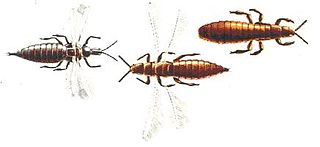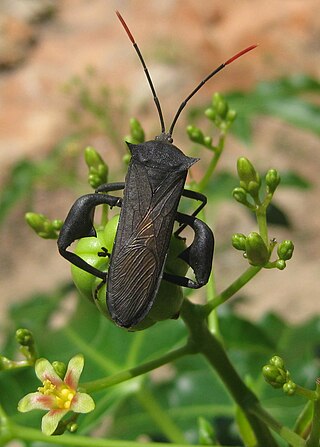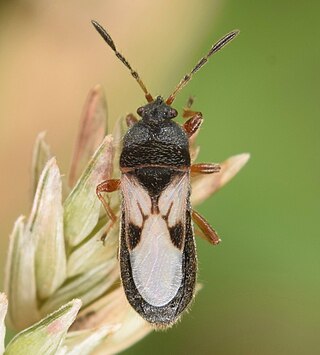
Insects in the family Tettigoniidae are commonly called katydids, or bush crickets. They have previously been known as "long-horned grasshoppers". More than 8,000 species are known. Part of the suborder Ensifera, the Tettigoniidae are the only extant (living) family in the superfamily Tettigonioidea.

Earwigs make up the insect order Dermaptera. With about 2,000 species in 12 families, they are one of the smaller insect orders. Earwigs have characteristic cerci, a pair of forcep-like pincers on their abdomen, and membranous wings folded underneath short, rarely used forewings, hence the scientific order name, "skin wings". Some groups are tiny parasites on mammals and lack the typical pincers. Earwigs are found on all continents except Antarctica.

Thrips are minute, slender insects with fringed wings and unique asymmetrical mouthparts. Entomologists have described approximately 6,000 species. They fly only weakly and their feathery wings are unsuitable for conventional flight; instead, thrips exploit an unusual mechanism, clap and fling, to create lift using an unsteady circulation pattern with transient vortices near the wings.

The American cockroach is the largest species of common cockroach, and often considered a pest. In certain regions of the U.S. it is colloquially known as the waterbug, though it is not a true waterbug since it is not aquatic. It is also known as the ship cockroach, kakerlac, and Bombay canary. It is often misidentified as a palmetto bug.

Coreidae is a large family of predominantly sap-sucking insects in the Hemipteran suborder Heteroptera. The name "Coreidae" derives from the genus Coreus, which derives from the Ancient Greek κόρις (kóris) meaning bedbug.

The small mountain ringlet or mountain ringlet is a butterfly of the family Nymphalidae. It is found in mountainous regions of southern and central Europe.

Treehoppers and thorn bugs are members of the family Membracidae, a group of insects related to the cicadas and the leafhoppers. About 3,200 species of treehoppers in over 400 genera are known. They are found on all continents except Antarctica; only five species are known from Europe. Individual treehoppers usually live for only a few months.

Blissus leucopterus, also known as the true chinch bug, is a small North American insect in the order Hemiptera and family Blissidae. It is the most commonly encountered species of the genus Blissus, which are all known as chinch bugs. A closely related species is B. insularis, the southern chinch bug.

Phyllophaga is a very large genus of New World scarab beetles in the subfamily Melolonthinae. Common names for this genus and many other related genera in the subfamily Melolonthinae are May beetles, June bugs, and July beetles. They range in size from 12 to 35 mm and are blackish or reddish-brown in colour, without prominent markings, and often rather hairy ventrally. These beetles are nocturnal, coming to lights in great numbers.

Tree crickets are insects of the order Orthoptera. These crickets are in the subfamily Oecanthinae of the family Gryllidae.
Oligonicella scudderi, common name Scudder's mantis or slender prairie mantid, is a species of praying mantis native to the southern United States. It is a small brown insect; the males can fly but the females are wingless.

Crickets are orthopteran insects which are related to bush crickets, and, more distantly, to grasshoppers. In older literature, such as Imms, "crickets" were placed at the family level, but contemporary authorities including Otte now place them in the superfamily Grylloidea. The word has been used in combination to describe more distantly related taxa in the suborder Ensifera, such as king crickets and mole crickets.

Lethocerus americanus, sometimes called electric light bug, is a giant water bug in the family Belostomatidae, native to southern Canada and the United States. It typically has a length around 5–6 cm (2.0–2.4 in). It was originally classified as a species in genus Belostoma.

Aphrophora alni, the European alder spittle bug, is a species belonging to the family Aphrophoridae.
Quadrangularis means "quadrangular" in Latin. Quadrangularis is the species name in the binomial nomenclature of several species:

Prosapia bicincta, the two-lined spittlebug, is a species of insect in the family Cercopidae. Adults are black with two red or orange lines crossing the wings. It reaches a length of 8–10 mm. It is widespread in the eastern half of the United States. A similar but possibly distinct species can be found throughout Central America where it is considered an agricultural pest.

Lepyronia coleoptrata is a species of spittlebug in the Aphrophoridae family. Native to Europe, this species has been introduced to northeast North America.

Eriocampa ovata, known generally as the alder sawfly or woolly alder sawfly, is a species of common sawfly in the family Tenthredinidae. The larvae feed on the leaves of the common alder and the grey alder, sometimes causing defoliation.

Usazoros hubbardi, commonly known as Hubbard's angel insect, is a species of insect in the order Zoraptera. It is native to the tropical and subtropical New World and has expanded its range into the eastern United States, where it lives in piles of sawdust, whereas in the hotter part of its range it lives under the bark of decomposing logs. It was named after the American entomologist Henry Guernsey Hubbard, who discovered the insect in the United States.
Amrasca biguttula, commonly known as the cotton jassid, is a subspecies of leafhopper belonging to the subfamily Typhlocybinae of family Cicadellidae. It is a pest of cotton, okra, and other crops in southern Asia and West Africa.

















